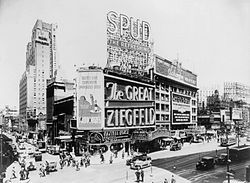Astor Theatre (New York City)
 The Astor Theatre in 1936 | |
| Address | 1537 Broadway Manhattan, New York United States |
|---|---|
| Coordinates | 40°45′29″N 73°59′08″W / 40.758001°N 73.98564°W |
| Type | Broadway |
| Construction | |
| Opened | September 21, 1906 |
| Closed | 1972 |
| Demolished | 1982 |
| Years active | 1906–1925 (live theater) 1925–1972 (movie theater) |
| Architect | George Keister |
The Astor Theatre was located at 1537 Broadway, at the corner with 45th Street, on Times Square in Midtown Manhattan, New York City. It opened on September 21, 1906, with Shakespeare's A Midsummer Night's Dream[1] and continued to operate as a Broadway theatre until 1925. From 1925 until it closed in 1972, it was a first-run movie theater.
History
The Astor was first managed by Lincoln A. Wagenhals and Collin Kemper, then by George M. Cohan and Sam Harris, and later by the Shubert Organization. The theater was designed by architect George W. Keister.[2] Among the plays that debuted at the Astor were Cohan's Seven Keys to Baldpate (1913) and Why Marry? (1917) by Jesse Lynch Williams, the first winner of the Pulitzer Prize for Drama.
In 1925, Loew's Theatres bought the Astor and converted it into a movie house in order to have a Times Square "road show" showcase for first-run films from the MGM film studio. The Big Parade (1925) was the first film shown at the Astor where it ran for a continuous 96-week engagement.[3] Other films to make their Times Square debuts at the Astor include The Phantom of the Opera (1925), The Broadway Melody (1929), Grand Hotel (1932), The Great Ziegfeld (1936) and Gone With the Wind (1939) for MGM; Alfred Hitchcock's Spellbound (1945) and the Beatles in A Hard Day's Night (1964) for United Artists; and Walt Disney's 20,000 Leagues Under the Sea (1954).
It was demolished in 1982 to make way for the Marriott Marquis Hotel.[4]
References
Notes
- ^ "Astor Theatre Opens With Lovely Spectacle" (PDF). The New York Times. September 22, 1906.
- ^ Morrison, p. 157
- ^ Bennett, Carl (February 15, 2016). "The Big Parade". Silent Era. Archived from the original on April 27, 2016. Retrieved February 4, 2017.
- ^ "Astor Theatre in New York, NY – Cinema Treasures". cinematreasures.org. Retrieved September 27, 2023.
Bibliography
- Morrison, Andrew Craig (2006). "Astor Theatre, 1537 Broadway, New York, New York". Theaters. New York: W. W. Norton. Pages 157–158 and photographs 4-039, 4-040, and 4-041. ISBN 0-393-73108-1.
External links